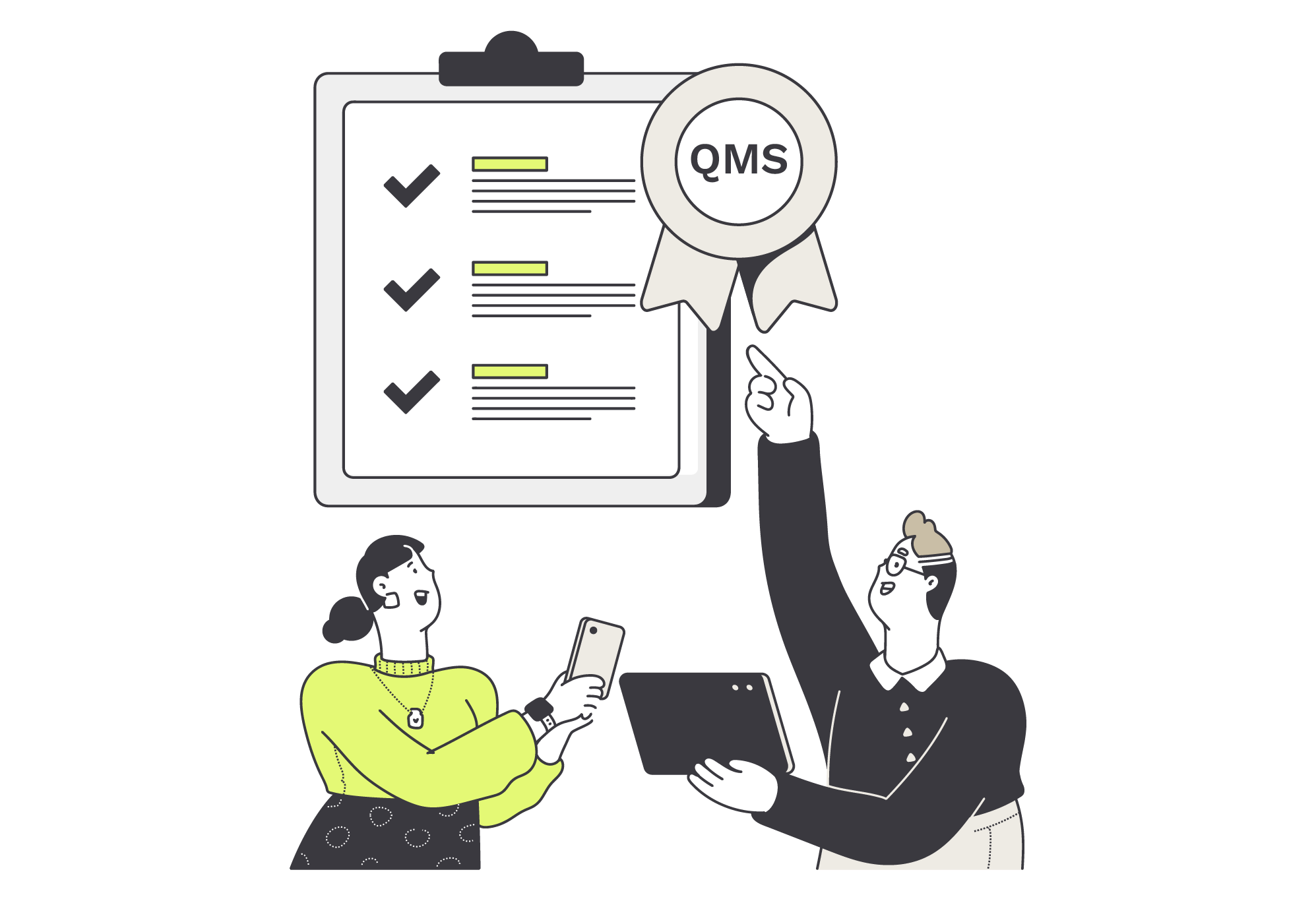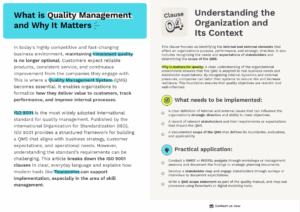The guide offers a practical interpretation of ISO 9001:2015 requirements, the international standard for Quality Management Systems (QMS). The ISO 9001 PDF breaks down each clause of the standard and explains how to implement its requirements in real organizational contexts.
The ISO 9001 PDF provides a detailed overview of the seven main clauses:
Each section of the ISO 9001 PDF includes:
• Why it matters for quality
• What must be implemented
• How to implement it, with practical tools and workflows
Clause 4 – Understanding Your Organization and Its Context
This clause requires identifying internal and external factors that impact the organization’s purpose and strategy. It also involves recognizing stakeholder needs and defining the QMS scope.
To implement it, conduct SWOT or PESTEL analyses and map stakeholders through surveys or interviews. Document the QMS scope and processes clearly. This ensures the QMS fits real business needs, reduces risks, and supports well-informed quality objectives.
Clause 5 – Leadership Commitment
This clause defines top management’s role in leading and supporting the QMS. It involves creating a quality policy, setting measurable quality objectives, and assigning leadership responsibilities. Strong leadership aligns the QMS with business goals, ensures resource allocation, and fosters a culture of continuous improvement.
To implement, co-create and communicate the quality policy, cascade objectives into team KPIs, and involve leaders in audits and reviews. This commitment builds trust, accountability, and drives quality performance.
Clause 6 – Planning for Success
This clause focuses on proactively managing risks and opportunities, setting quality objectives, and planning actions to achieve them. It ensures alignment with strategic goals and readiness for change.
To implement, use structured methods like brainstorming or FMEA to identify risks and maintain a risk register. Set SMART quality objectives with assigned owners and monitor progress. Employ change management tools to evaluate and control process changes. Effective planning optimizes resources and minimizes disruptions.
Clause 7 – Support Functions
This clause covers the resources needed to support the QMS, including people, infrastructure, and communication. It ensures tools and documentation are available and controlled.
Implement a resource allocation framework and manage workforce competence, using tools like Teammeter’s Skills Management Software to close skill gaps. Maintain documented information and establish communication processes to promote quality awareness. Conduct regular planning to assess needs and monitor training. Consistent support builds reliability and engagement across the organization.
Clause 8 – Operational Control
This clause ensures effective control over operational processes that deliver products or services. It covers planning, customer communication, design, production, and handling nonconformities.
Implement clear operational procedures, manage customer and supplier requirements, and ensure traceability. Use formal reviews, supplier scorecards, and inspections to maintain quality. Establish a system to identify and resolve nonconformities with root cause analysis and corrective actions. Strong operational control drives consistent quality and customer confidence.
Clause 9 – Performance Review
This clause requires monitoring, measuring, and evaluating the QMS effectiveness through audits and management reviews. It helps identify strengths and areas needing improvement, supporting informed decisions.
Implement performance indicators aligned with quality objectives and schedule regular internal audits. Use dashboards to visualize KPIs and share results with management. Conduct quarterly management reviews to analyze findings and plan corrective actions. Continuous performance review ensures the QMS remains effective and aligned with goals.
Clause 10 – Continuous Improvement
This clause focuses on enhancing the QMS through corrective actions and ongoing improvement efforts. It promotes learning from nonconformities and encourages a proactive culture.
Implement a documented process for identifying and correcting issues, using root cause analysis tools like 5 Whys or fishbone diagrams. Establish a system for logging nonconformities and a platform for employee suggestions. Regularly review improvements during team meetings to drive innovation and resilience.
Teammeter: Enhancing Skill Management for Quality
A key success factor in implementing ISO 9001 is ensuring that the right people have the right skills. Teammeter’s Skills Management Software supports this by offering a role-based skill matrix that helps organizations assess current competencies, identify gaps, and develop targeted training plans.
By aligning skill development and team feedback with ISO 9001 objectives—particularly in areas such as competence, documentation, and performance improvement—Teammeter helps operationalize these requirements. This integration transforms compliance into a strategic advantage, enabling continuous improvement and a stronger quality culture.
A full version of the ISO 9001 PDF is available as a downloadable PDF for reference, training, or onboarding support.
Additional Resources:
ISO 9001:2015 Official Standard — The definitive source for the Quality Management System standard.
American Society for Quality (ASQ) ISO 9001 Resources — Expert articles and best practices on quality management.


